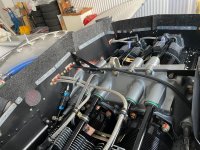Continuing my journey in installing System32 electronic ignition in my RV-4, I've begun sizing and crimping the spark plug wires.
However, the resistance I'm seeing looks very high - 25kΩ for a wire a few feet long. I know this is within spec for automotive cables, but I want to double check before crimping the rest in case I'm doing something stupid (these are the fold-back type which are slightly fiddly). I've seen some specs saying 50Ω per foot which is way off what I'm seeing.
Does what I'm seeing look about right? Does touching a multimeter probe against a non-crimped conductor give the reading of the wire itself, proving the crimp is good/bad? Or does the probe on its own not make good enough contact to give a reading with this type of wire?
However, the resistance I'm seeing looks very high - 25kΩ for a wire a few feet long. I know this is within spec for automotive cables, but I want to double check before crimping the rest in case I'm doing something stupid (these are the fold-back type which are slightly fiddly). I've seen some specs saying 50Ω per foot which is way off what I'm seeing.
Does what I'm seeing look about right? Does touching a multimeter probe against a non-crimped conductor give the reading of the wire itself, proving the crimp is good/bad? Or does the probe on its own not make good enough contact to give a reading with this type of wire?





